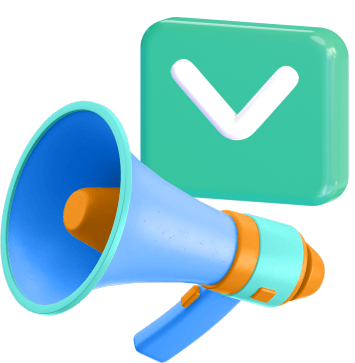- Home
- Blog
- Conversion Rate Optimization How to Make a Perfect Sales Pitch for Your Products or Services
How to Make a Perfect Sales Pitch for Your Products or Services
-
 Published: Jan 2, 2024
Published: Jan 2, 2024
-
 8 min. read
8 min. read
-
 Matthew Gibbons
Matthew Gibbons Lead Data & Tech Writer
Lead Data & Tech Writer
- Matthew is a marketing expert focusing on the SEO & martech spaces. He has written over 500 marketing guides and video scripts for the WebFX YouTube channel. When he’s not striving to put out some fresh blog posts and articles, he’s usually fueling his Tolkien obsession or working on miscellaneous creative projects.
In this video, Chris from our Strategy team will explain how to write a top-tier sales pitch for your business. Keep reading to learn more!
Transcript:
Hey guys! Listen — you should buy our services.
Um… why didn’t that work?
Huh? What do you mean, I have to “explain how our services can help them?” What are you talking about?
Sales pitch? What’s that?
I’m just kidding. I know what a sales pitch is. In case you don’t, a sales pitch is basically a brief sales presentation you give to prospective customers to explain what you sell and how it can make their lives easier. So, if you didn’t already know, now you do. But do you know how to create a good sales pitch?
That’s what we’re here to talk about. In this video, we’ll go over eleven tips for how to make a perfect sales pitch. We’ll start with a few general tips, and then we’ll talk about what to include at the beginning, middle, and end of your pitch.
Before we go on, be sure to subscribe to our YouTube channel. Now let’s dive into it!
Don’t miss our Marketing Manager Insider emails!
Join 200,000 smart marketers and get the month’s hottest marketing news and insights delivered straight to your inbox!
Enter your email below:
Inline Subscription Form – CTA 72
“*” indicates required fields
(Don’t worry, we’ll never share your information!)

How to make a perfect sales pitch
As promised, we’ll start with three general sales pitch tips.
1. Keep it concise
The first and most important thing to remember when building a sales pitch is to keep it concise. That means it should be efficient, clear, and to the point.
There are different contexts where you could give your sales pitch. You might put it on the homepage of your website, deliver it to someone you meet at a business conference, or explain at the beginning of a phone call.
In any of those cases, you need to be able to deliver your message quickly and clearly, because your audience won’t just sit there listening to you ramble for an hour. Ideally, your sales pitch should last about one or two minutes. In fact, sales pitches can also be called ‘elevator pitches’ because they should not exceed the length of an average elevator ride.
2. Make it a conversation
Another way to upgrade your sales pitch is to treat it as a conversation. Now, obviously, this doesn’t always work — if you’re just putting it on the homepage of your website, it can’t really be a conversation. But if you’re giving your sales pitch out loud to a specific person, try not to make it a monologue.
Instead, build up to it with a conversation. Find something unique about the person you’re talking to, and then tie that into your pitch. Also, give them the opportunity to respond to your pitch as you’re delivering it. By personalizing the pitch to your audience, you’ll have a better chance of reaching them.
The key to sales is listening to your audience. If you’re not listening, then you don’t truly understand the needs of the people you’re pitching to.
3. Pair facts with emotional appeals
Our third general sales pitch tip is that you should include both hard facts and emotional appeals. You students of rhetoric out there will know that this is called logos and pathos.
On the one hand, you should cite some data (logos) to demonstrate the value of your product or service. But you should also be sure to tie it back to your audience’s specific wants and needs, like their fear (pathos) of missing out.
What to do at the beginning of your sales pitch
Now that we’ve gone over some general tips, let’s look at what to include at each stage of your sales pitch, starting with — well — the beginning.
1. Ask a question
One way you can begin your sales pitch is by asking a question. And I don’t mean a completely random question like, “What’s the airspeed velocity of an unladen swallow?” No, you want the question to be a relevant lead-in to your elevator pitch.
So, let’s say you sell task management software for businesses. In that case, you might ask a question like, “Do you ever feel overwhelmed trying to keep up with your to-do list? Like it can get really disorganized?”
That allows you to connect with your audience’s pain points right from the get-go, so you can then easily segue into your value proposition — which we’ll get to later.
2. Provide a statistic
Another way you can start off a business pitch is with a statistic. This one might be a little more awkward to work into a conversation with someone you just met, but it’s great for sales pitches that you put on the homepage of your website.
For example, if you sell pest control services, you might start by saying, “Locations treated with our pest control services are 90% less likely to be invaded by an army of giant rats.” Of course, only use that statistic if it’s true.
Anyway, a stat like that really grabs people’s attention and makes them aware of how valuable your services are.
3. Use a personal anecdote
Finally, you could try starting off the pitch with a personal anecdote. This works great in casual conversations. You can relate your story to one of your audience’s pain points.
So, if you sell data management platforms, or DMPs, you could tell a brief story about how much you struggled to keep up with data at your last job, but how much better things got once you started using a DMP. That can lead you right into the rest of your pitch.
What to do in the middle of your sales pitch
Now let’s talk about what the middle of your sales pitch should look like. This is the meat of your pitch, so it might be the most important part.
1. Explain what you do using USPs
After your intro, it’s time to briefly explain what your company does. Obviously, this step is pretty important. Imagine giving a whole pitch without actually bothering to mention what you sell! Wouldn’t be very effective.
Besides mentioning your product or service, be sure to talk about the company itself. Throw in a couple of unique selling propositions, or USPs, to set yourself apart from the competition. This might include results you’ve driven or something you do for customers that no one else does.
2. Define your customers and their pain points
Now that you’ve established who you are and what you offer, move the conversation back to the potential customer.
Explain whom you sell to and what their pain points are. This is a great place to tie back to your intro, where hopefully you brought up your audience’s pain point through an anecdote or question.
Establishing the problem your audience has sets you up to present a value proposition that addresses their needs, which is the next step.
3. Offer a value proposition
Maybe the most important part of the whole sales pitch is the value proposition. But what’s a value proposition? Basically, it’s a short statement where you explain how your product or service benefits your customers.
The best way to create an effective value proposition is to show how your product or service addresses the problems you mentioned in the last step. Then you can lay out how your company helps your customers succeed and what that success looks like.
What to do at the end of your sales pitch
Finally, let’s talk about how you should end your sales pitch. There are a couple of ways you can wrap things up.
1. Ask an engaging question
Firstly, you can finish off with an engaging question. This is optional, of course, and it depends on whether you plan on continuing the conversation. If you’re giving a literal elevator pitch, you’re probably going to part ways as soon as the doors open, so maybe this isn’t the way to go.
On the other hand, if your pitch happens in the middle of a larger conversation, a question can keep that conversation going and give the prospective customer a chance to talk more about your product or service. For instance, you could ask something as simple as, “Can you think of ways that this product would be great for your business?”
2. Include a CTA
Finally, make sure you include a call to action, or CTA, at the end of your sales pitch. Your pitch won’t mean anything if you don’t tell your audience what you want them to do with the information you’ve just given them.
If your sales pitch is online, your CTA might involve clicking on a link or signing up for an email list. If it’s in the context of a conversation, maybe the CTA would be a request for them to call you later about your product or service. Either way, make sure your audience knows which action you want them to take next.
We foster and form long-term partnerships so that your business has long-term results.
Over 90% of WebFX clients continue partnering with us into year 2 of their campaign.
Hear from Our Happy Customers

Learn more about how to boost conversions and sales with WebFX
Well, that’s it for this video! Now you know how to make a sales pitch that will drive conversions for your business. If you want to learn more helpful digital marketing tips, be sure to subscribe to our YouTube channel, and to our email newsletter, Revenue Weekly.
Thanks for watching, and I’ll see ya next time!
-
 Matthew is a marketing expert focusing on the SEO & martech spaces. He has written over 500 marketing guides and video scripts for the WebFX YouTube channel. When he’s not striving to put out some fresh blog posts and articles, he’s usually fueling his Tolkien obsession or working on miscellaneous creative projects.
Matthew is a marketing expert focusing on the SEO & martech spaces. He has written over 500 marketing guides and video scripts for the WebFX YouTube channel. When he’s not striving to put out some fresh blog posts and articles, he’s usually fueling his Tolkien obsession or working on miscellaneous creative projects. -

WebFX is a full-service marketing agency with 1,100+ client reviews and a 4.9-star rating on Clutch! Find out how our expert team and revenue-accelerating tech can drive results for you! Learn more
Try our free Marketing Calculator
Craft a tailored online marketing strategy! Utilize our free Internet marketing calculator for a custom plan based on your location, reach, timeframe, and budget.
Plan Your Marketing Budget

Looking for More?
Get expert ideas, industry updates, case studies, and more straight to your inbox to help you level up and get ahead.
"*" indicates required fields
Try our free Marketing Calculator
Craft a tailored online marketing strategy! Utilize our free Internet marketing calculator for a custom plan based on your location, reach, timeframe, and budget.
Plan Your Marketing Budget





